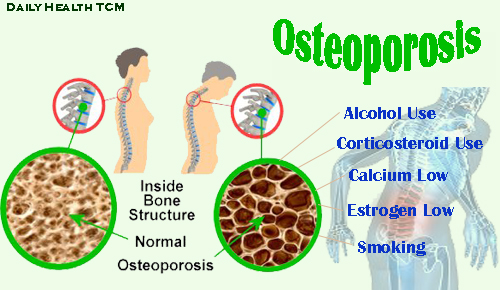Osteoporosis is a disease that affects bone also called porous bone. This disease has distinctive properties such as low bone mass, along with micro-architecture of bone and decrease quality of bone tissue that can ultimately lead to bone loss.
Osteoporosis almost no symptoms and attacks are silent disease so this said to be a sneaky disease.
Causes
1. Postmenopausal Osteoporosis
Postmenopausal Osteoporosis is occurs due to estrogen deficiency in women is the main hormone that helps regulate the transport of calcium into the bones. Symptoms of the disease usually occurs in women aged between 51-75 years, but the symptoms can appear faster or slower.
2. Senile Osteoporosis
Senile Osteoporosis occurs due to calcium deficiency related to age and the imbalance between the speed of bone destruction and formation of new bone. Senile means that this situation only occurs in the elderly. This disease usually occurs at the age of 70 years and 2 times more common in women. Senile osteoporosis is also more common in women.
3. Secondary Osteoporosis
Secondary Osteoporosis is caused by another medical condition or by drugs. The causes include chronic renal failure and hormonal disorders (especially thyroid, parathyroid and adrenal) and drugs (eg. corticosteroids, barbiturates, anti-seizure and excessive thyroid hormone). Excessive alcohol consumption and smoking can aggravate the situation. Less than 5% of patients with osteoporosis is also have osteoporosis secondary.
4. Osteoporosis Juvenile
Idiopathic juvenile osteoporosis occurs in children and young adults who have hormone levels and the function of normal, normal vitamin levels and does not have an obvious cause of the fragility of the bones. This type of osteoporosis is unknown the exact cause.
Some patients with this disease has no specific symptoms. The disease is known after the examination. But there are common symptoms of osteoporosis are :
1. Bone density decrease slowly (especially in patients with senile osteoporosis), so at the beginning of osteoporosis does not cause symptoms. If bone density is greatly reduced so that the bone collapse or is destroyed, it will develop bone pain and deformity.
2. Collapse vertebrae cause chronic back pain. Fragile spine can collapse spontaneously or with minor injuries. Usually the pain occur suddenly and be felt in certain areas of the spine, which will increase the pain if the person is standing or walking. If touched, the area will be sore, but usually this pain will disappear gradually after a few weeks or a few months. If some spine crushed, it will form an abnormal curvature of the spine, which causes muscle tension and pain.
3. Other bones can be broken, which is often caused by light pressure or due to falls. One of the most serious fractures are hip fractures. In addition, in patients with osteoporosis, fractures tend to heal slowly.
To prevent the occurrence of osteoporosis can do the following things :
1. Maintaining or increasing bone density by consuming adequate calcium
2. Exercise with weights such as walking and stairs will increase bone density. Swimming is not increasing bone density
3. Consuming drugs for certain people such as estrogen helps maintain bone density in women and is often taken together with progesterone. The most effective esttrogen replacement therapy begins within 4-6 years after menopause; but it started more than six years after menopause, they can slow bone loss, but had no effect on the breast or uterus. To prevent osteoporosis, bisphosphonates (eg. alendronate), can be used alone or in conjunction with hormone replacement therapy.

